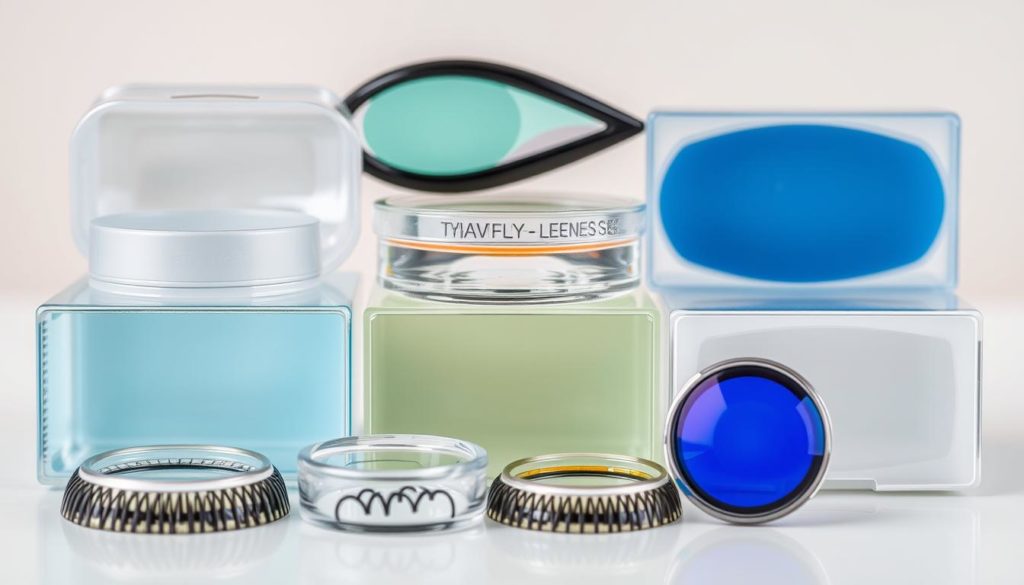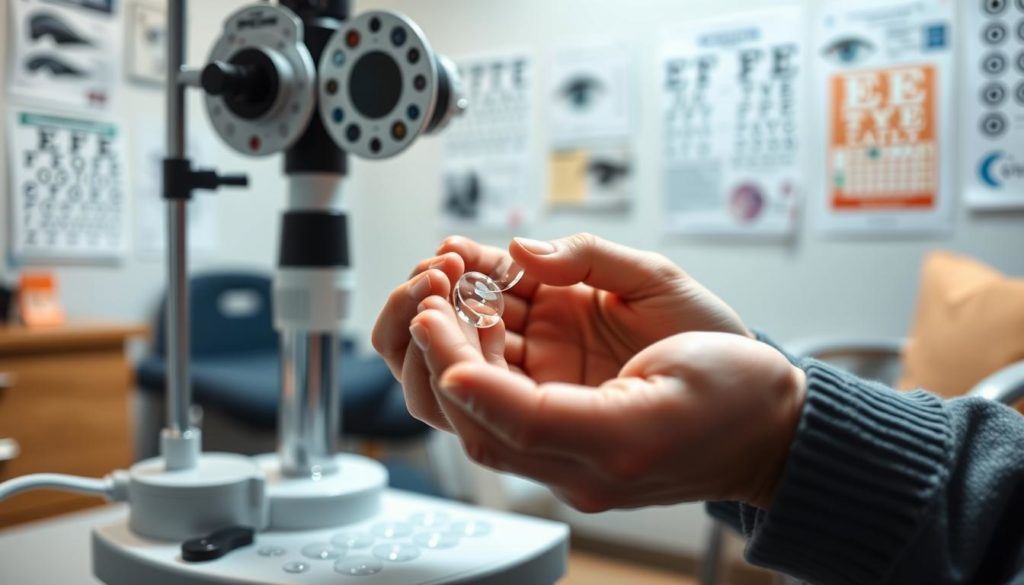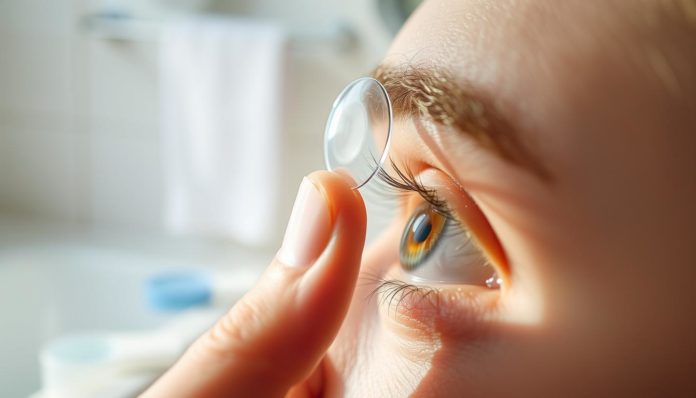Did you know over 45 million people in the United States wear contact lenses? They offer a convenient alternative to glasses. If you’re tired of glasses or want a change, learning about contact lenses is key.
In this guide, we’ll cover the basics to help you start confidently. You’ll learn about different types of lenses and how to keep them clean. The American Optometric Association and eye care experts will guide you.
Stay with us as we explore how to begin with contact lenses. We’ll give you the basics to wear them successfully. Let’s start on the path to clearer vision!
Understanding Different Types of Contact Lenses
Starting with contact lenses can feel overwhelming. There are many types, like soft and rigid gas permeable lenses, daily disposables, and extended wear lenses. Let’s explore each to help you choose wisely.

Soft Contact Lenses
Soft contact lenses are the most popular. They’re made from a gel-like material that fits your eye well. They’re comfortable and easy to use. You can find them in different styles, like spherical, toric, and multifocal, to meet various vision needs.
Rigid Gas Permeable Lenses
RGP lenses are durable and offer clear vision. They might take some getting used to but last long. They also let a lot of oxygen into your eye. They’re great for people with specific eye problems, like astigmatism.
| Type of Lens | Material | Comfort | Durability |
|---|---|---|---|
| Soft Contact Lenses | Hydrogel | High | Moderate |
| Rigid Gas Permeable Lenses | Polymethyl methacrylate (PMMA) | Moderate | High |
Extended Wear Lenses
Extended wear lenses are for wearing all day and night for up to a month. They let a lot of oxygen in to keep your eyes healthy. But, always follow your eye doctor’s advice to avoid problems.
Daily Disposable Lenses
Daily disposable lenses are for one-time use. They’re easy and clean to use every day. They’re great for beginners because they’re simple and keep your eyes healthy.
Getting an Eye Exam and Contact Lens Fitting
The first step to try contact lenses is an eye exam for contact lenses with an optometrist. This exam checks your eye health and finds the right contact lens for you. The optometrist will measure your eye, like the corneal curvature and pupil size, for a perfect fit.
Talking about your lifestyle is also key. Different lenses are for different needs and activities. Getting lenses that fit well is crucial for comfort and eye health.
| Step | Description |
|---|---|
| Initial Consultation | Discussion about your vision needs and lifestyle to determine the best type of lens. |
| Measurement | Precise measurements of your cornea, pupil size, and other eye structures. |
| Trial Lenses | Try different lenses to find the best fit and comfort level. |
| Final Fitting | Receiving a prescription for lenses that fit your eyes perfectly and comfortably. |

After the exam, you’ll try out contact lens fitting process with trial lenses. This ensures your lenses correct your vision and are comfortable. The optometrist will teach you how to put in and take out your lenses correctly.
Getting a precise prescription and a proper fit is crucial. Regular check-ups are important to keep your eyes healthy and your lenses fitting right. These steps are essential for anyone starting with contact lenses.
How to Properly Insert and Remove Contact Lenses
Starting with contact lenses can seem tough at first. But, with the right steps and a bit of practice, it gets easier. Here are some key tips for new users to make wearing lenses smooth and comfy.
Steps for Inserting Contact Lenses
Inserting lenses right is key. Follow these steps to do it correctly:
- Wash Your Hands: Start by washing your hands with soap and water. Dry them well with a clean towel.
- Inspect the Lens: Make sure the lens is clean and moist. It should not be dry.
- Position Correctly: Place the lens on your index finger tip. It should curve upwards like a cup.
- Hold Your Eye: Use your other hand to hold your upper eyelid. Pull down your lower eyelid with your middle finger.
- Insert the Lens: Gently put the lens on your eye. Look up and slowly let go of your eyelid. Blink a few times to center it.
- Confirm Placement: Check that the lens is in place and your vision is clear.
Steps for Removing Contact Lenses
Removing lenses is just as important as putting them in. Follow these steps to do it right:
- Wash Your Hands: Clean your hands before touching your eyes.
- Locate the Lens: Look up and pull down your lower eyelid. Use your index finger to slide the lens to the lower part of your eye.
- Pinch and Remove: Softly pinch the lens with your thumb and index finger. Look up and away as you lift the lens off your eye.
- Store Properly: Put the lens in its case with fresh solution.
Common Mistakes to Avoid
Here are some mistakes to watch out for to avoid discomfort or damage:
- Skipping Hand Washing: Always wash your hands to prevent eye infections.
- Inserting Wrong Side: Make sure the lens is not inside out. The edges should curve upwards.
- Using Expired Solution: Always use fresh, unexpired solution for cleaning and storing lenses.
- Overwearing: Don’t wear lenses longer than your eye doctor recommends.
- Sleeping with Lenses: Unless prescribed, avoid sleeping with contact lenses to prevent eye irritation.
With these tips, inserting and removing lenses can be easy and comfy. Remember, practice makes perfect. Give yourself time to get used to the routine!
Daily Cleaning and Maintenance for Contact Lenses
Proper daily contact lens care is key to eye health. Regular cleaning stops infections and keeps you comfortable. Here are some important contact lens cleaning tips and best practices.
- Always wash your hands thoroughly with soap and water before handling your lenses.
- Cleansing: Use an appropriate contact lens solution as recommended by your eye care professional. Never use tap water.
- Rinsing: Rinse each lens for a few seconds with the solution to remove debris.
- Disinfecting: Place the lenses in a clean lens case filled with fresh disinfecting solution and soak them overnight.
Storing your lenses right is also crucial. Make sure your contact lens case is clean and replaced often to avoid contamination.
Here’s a quick comparison between various cleaning solutions:
| Solution Type | Benefits |
|---|---|
| Multipurpose Solution | Convenient all-in-one solution for cleaning, rinsing, disinfecting, and storing lenses. |
| Hydrogen Peroxide Solutions | Effective deep cleaning option, requires neutralization before lens wear. |
| Saline Solution | Primarily used for rinsing and storing, not for disinfecting. |
| Daily Cleaners | Specifically for cleaning, usually used with an additional disinfecting solution. |
By following these contact lens cleaning tips and practicing daily contact lens care, you can keep your eyes healthy. Always follow your eye care specialist’s advice for your specific lenses.
Beginner Tips for Contact Lenses
Starting with contact lenses? Good habits from the beginning are key for comfort and safety. Here are some beginner tips for contact lenses. They help keep your lenses clean and hydrated.
Always Wash Your Hands
Before touching your contact lenses, wash your hands well with soap and water. This step is essential for keeping your lenses clean and preventing eye infections. Dry your hands with a lint-free towel to avoid fibers on your lenses.
Keep Your Lenses Hydrated
Keeping your lenses hydrated is crucial. It helps prevent dry eyes and makes them more comfortable. Use rewetting drops as needed and store your lenses in fresh solution when not in use.
Follow the Wear Schedule
It’s important to follow the wear schedule your optometrist gives you. Wearing lenses too long can cause dryness, irritation, and infections. Always stick to your optometrist’s advice and never sleep in lenses unless they’re made for it.
Contact Lens Wearing Tips for Comfort
Wearing contact lenses can be comfy if you follow some important tips. Don’t wear them all night, use rewetting drops, and keep your lenses clean. These steps will help you see clearly without feeling uncomfortable.
Avoid Sleeping with Lenses
It’s a big no-no to sleep in your contact lenses. Even if they’re made for longer wear, they still cut down on oxygen to your eyes. This can lead to infections or irritation. So, always take out your lenses before you sleep to let your eyes rest.
Use Rewetting Drops
Dry eyes are common with contact lenses, but rewetting drops can fix it. These drops keep your eyes moist and stop dryness. They make your lenses feel good all day. Blink Contacts and Systane offer great options for rewetting your lenses.
Maintain Proper Hygiene
Keeping your lenses clean is key. Always wash your hands before touching your lenses to avoid bacteria. Clean your lenses often and change your lens case every three months. This keeps your lenses in top shape.
- Avoid sleeping with lenses to prevent reduced oxygen supply.
- Use rewetting drops for lenses to combat dryness and maintain moisture.
- Adhere to contact lens hygiene tips to avoid eye infections and discomfort.
Recognizing Signs of Contact Lens Problems
Wearing contact lenses can greatly improve your vision without glasses. But, it’s key to watch out for contact lens issues to keep your eyes healthy. Spotting eye infections early is especially important, as they can come from poor lens care or use.
Contact lens discomfort is often the first sign of trouble. Look out for redness, itching, and a gritty feeling in your eyes. These symptoms should not be ignored.
“Always pay attention to any unusual sensations or changes in your vision when wearing contact lenses,” advises the American Academy of Ophthalmology.
Other signs of signs of eye infections include:
- Persistent eye pain: Feeling a constant ache that doesn’t go away after removing lenses.
- Excessive tearing or discharge: Any unusual discharge or increase in tearing can be a sign of infection.
- Blurry vision: Unexpected changes in vision clarity can signal serious problems.
To avoid these issues, keep your lenses clean and follow care guidelines. Regular eye exams are also crucial. They help catch any contact lens discomfort or eye infections early, making them easier to manage.
Best Practices for New Contact Lens Wearers
Starting to wear contact lenses is both exciting and a bit scary. Getting into good habits early on makes the transition smoother and keeps your eyes healthy. Here are some key practices for new contact lens users to help you begin well.
Start Slow
It’s important to let your eyes get used to contact lenses slowly. Start by wearing them for a few hours a day and then increase the time. This helps your eyes adjust without getting too tired or sore. Finding the right balance is key to wearing your lenses comfortably.
Listen to Your Eyes
Your eyes will let you know if something’s off, so pay attention. If you notice redness, discomfort, or blurry vision, take out your lenses right away and see an eye doctor. Not listening to your eyes can lead to bigger problems. Always put your eye health first to avoid complications.
Have Regular Check-Ups
Regular eye exams are a must for contact lens users. Visiting your optometrist regularly keeps your prescription current and your eyes healthy. These visits can catch problems early and help adjust your lenses or wear habits. Regular eye check-ups are a key part of being a new contact lens wearer.
FAQ
What are the best contact lens tips for beginners?
For new contact lens users, wash your hands well before touching lenses. Keep your lenses clean and moist. Always follow the wear schedule your eye doctor gives you.
How do I start with contact lenses?
First, get an eye exam and fitting from an optometrist. They’ll check your eyes, pick the right lenses, and teach you how to use them.
What types of contact lenses are available?
There are many contact lenses, like soft and rigid gas permeable ones. There are also extended wear and daily disposable lenses. Talk to your eye doctor to find the best one for you.
What should I expect during a contact lens fitting?
At a fitting, your eye doctor will measure your eyes and check your prescription. They’ll also try different lenses to make sure they fit right and are comfortable.
How do I properly insert and remove contact lenses?
To put in lenses, wash your hands and use your fingers to open your eyes. Place the lens on your eye. To take them out, look up and gently pull down your lower eyelid. Pinch the lens to remove it. Always follow your eye doctor’s steps.
What are the daily cleaning and maintenance practices for contact lenses?
Clean your lenses with a solution every day. Store them in a clean case with fresh solution. Replace your lenses and case as needed. Keeping them clean is key to avoiding infections.
What are some beginner tips for contact lenses?
Always wash your hands before touching your lenses. Use rewetting drops to keep your eyes moist. Follow the wear schedule your eye doctor gives you.
How can I ensure comfort while wearing contact lenses?
To stay comfortable, don’t sleep in your lenses. Use rewetting drops to keep your eyes moist. Keep your lenses and case clean to avoid discomfort and infections.
How do I recognize signs of contact lens problems?
Watch for redness, irritation, too much tearing, or blurry vision. If you see these signs, take out your lenses and see your eye doctor right away. This can help prevent serious problems.
What are the best practices for new contact lens wearers?
Start slow when getting used to your lenses. Listen to your eyes and watch for any discomfort. Have regular check-ups with your eye doctor to keep your eyes and lenses healthy.


